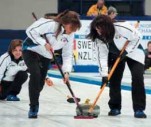High-Rise Curling Construction on the Deep Draft Foundation

Russia is a huge construction site, but the buildings designed and erected there usually have an extremely low coefficient of effective pressure (CEP). Usually the CEP is no higher than 0.2 and it is only due to the fact that the undersoil is always estimated according to the second rate of the limit state, i. e. to the linear strain. The CEP will dramatically improve, if the undersoil is estimated according to the first rate of the limit state, i.e. to the bearing capability. “The method of sitting buildings on the soft ground” (licensed in Russia # 2167243) brings the CEP to 1.0, and “the method of increasing the strength of the soft ground” (licensed in Russia # 2170305) raises the CEP above 1.0.
The way buildings are constructed on the nonlinear foundation can be described with the help of curling – a sport game in which the way the curling stone moves on the surface of ice is managed by the brushes of the members of the crew who are in charge of it. In the patented methods, however, the movements of curling buildings are vertical and they are managed by hydraulic cells.
Both horizontal and vertical largescale curling adjustment is used in Canada during the transportation of constructional projects. For instance, this is the way the 60-meter elevator was transported within 30 km along winding unpaved roads full of up- and downhills.
Such transportation of large-tonnage high-rise buildings is carried out by rubber-tyred carriers with a set of hydraulic jacks. If during transportation the ongoing tilts tend to exceed the allowed limit, which is 9 degrees for the main frame, they are managed by jacks. At the same time it is very important not to overload the jacks or the wheels.
Full content of this issue you can read here
The full version of the article can be read in our printed issue, also you can subscribe to the web-version of the magazine
 Text by: VICTOR IRKHIN, construction engineer, artisan
Text by: VICTOR IRKHIN, construction engineer, artisan


